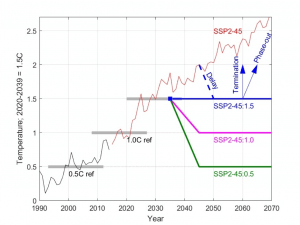GAUSS: Geoengineering Assessment across Uncertainty, Scenarios, and Strategies

Our goal is to help support future informed decisions surrounding climate engineering (or solar geoengineering), and stratospheric aerosol injection (SAI) in particular. A hypothetical decision-maker (whether a policy-maker or public more broadly) will want to know answers to questions such as: What are my choices? What will happen if we make any given choice? How confident are we? Making informed choices thus requires viewing SAI not as “one thing” with one best guess of outcomes, but rather requires a more holistic assessment, for a range of possible future scenarios, for different possible strategies on how deployment might be done, and furthermore an assessment that captures uncertainty. This is the goal of GAUSS: assessing geoengineering across these three dimensions. Simulations that span this space will be available to the broader research community for understanding how the impacts depend on these dimensions.
We have completed two sets of simulations of stratospheric aerosol intervention in CESM(WACCM); the first spans different scenarios for possible implementation (different amounts of cooling, start date, inconsistencies) for a single “strategy”, while the second spans different strategies, e.g., different latitudes of injection and different goals, for the same cooling target and start date. More generally, we aim to consider a range of scenarios, a range of strategies, and all for different uncertainties described both by considering several models, and through using perturbed physics in a single model. Our simulations under GAUSS have been conducted in the “middle-atmosphere” version of CESM2(WACCM) (so only full chemistry in the stratosphere); a subset of the scenarios and a single strategy have been conducted in the full-chemistry CESM2(WACCM); these constitute the ARISE simulations. Similar simulations have also been conducted in UKESM.
Scenario and strategy choices:
- We consider only a “current policy” (SSP2-45) emission scenario.
- We include targets of constant global-mean-temperature at roughly 1.5C above pre-industrial (we define as the 2020-2039 average) as well as 1.0C and 0.5C. Most simulations start in 2035, but we also include a “delayed start” beginning in 2045. Simulations end in 2069. (Note that the longer-term trajectory is relevant, but not necessary to simulate in an ESM.) The 1.5C case has also been conducted as part of ARISE; the delayed-start and the 1.0C target will also be conducted as part of ARISE.
- We have included some departures from these trajectories (termination, phase-out, interruptions).
- All of the above use injections at 15º and 30º N/S as in previous work, and based on preparatory simulations we performed in multiple climate models. We have also simulated a number of “symmetric” strategies, using (i) equatorial, (ii) 15N and S, (iii) 30N and S, or (iv) 60N and S, as well as a strategy targeting the Arctic. Future cases will include multiple uncoordinated efforts as well.
- We have conducted simulations in CESM2(WACCM6-MA), with a larger ensemble (and a smaller amounts of cases) in CESM2(WACCM6-TSMLT).
- Simulations have been conducted with other models (UKESM, GISS).
All simulations use a feedback algorithm so that comparisons can be made in terms of what is needed to achieve given goals rather than comparing similar injection rates.

An overview paper has been published in PNAS. Please contact Dan if you are interested in using output from GAUSS simulations. An overview talk of GAUSS was given by Dan at NCAR in November 2022 and can be found here.
